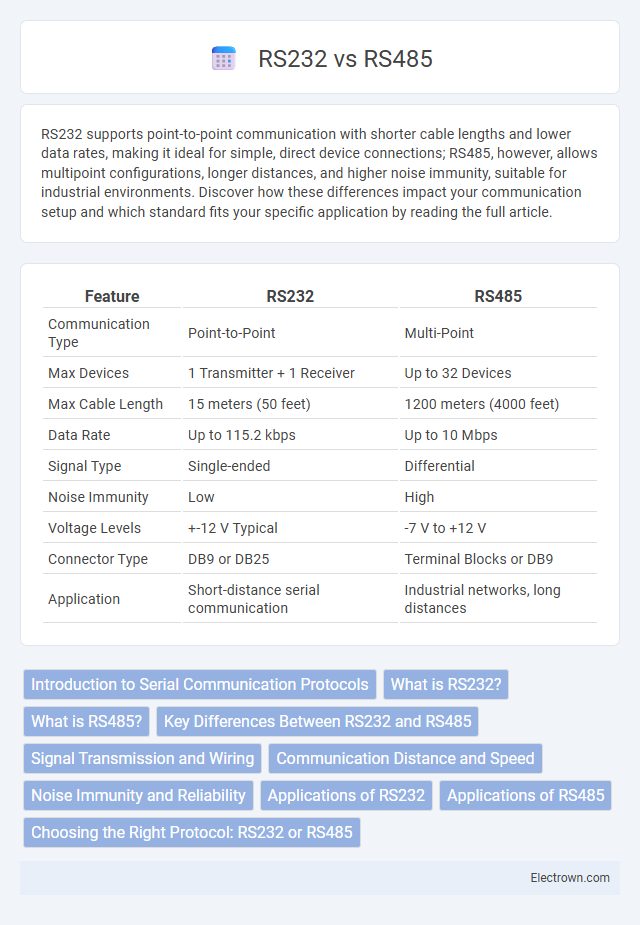RS232 supports point-to-point communication with shorter cable lengths and lower data rates, making it ideal for simple, direct device connections; RS485, however, allows multipoint configurations, longer distances, and higher noise immunity, suitable for industrial environments. Discover how these differences impact your communication setup and which standard fits your specific application by reading the full article.
Table of Comparison
| Feature | RS232 | RS485 |
|---|---|---|
| Communication Type | Point-to-Point | Multi-Point |
| Max Devices | 1 Transmitter + 1 Receiver | Up to 32 Devices |
| Max Cable Length | 15 meters (50 feet) | 1200 meters (4000 feet) |
| Data Rate | Up to 115.2 kbps | Up to 10 Mbps |
| Signal Type | Single-ended | Differential |
| Noise Immunity | Low | High |
| Voltage Levels | +-12 V Typical | -7 V to +12 V |
| Connector Type | DB9 or DB25 | Terminal Blocks or DB9 |
| Application | Short-distance serial communication | Industrial networks, long distances |
Introduction to Serial Communication Protocols
RS232 and RS485 are widely used serial communication protocols designed for data exchange between devices. RS232 supports point-to-point communication with short cable lengths and lower speeds, making it suitable for simple device connections. RS485 enables multi-point communication over longer distances with higher noise immunity, ideal for industrial networks where multiple devices share a communication bus.
What is RS232?
RS232 is a standard protocol for serial communication, primarily used to connect computers and peripherals over short distances. It transmits data using single-ended signals with voltage levels ranging from -15V to +15V, supporting speed up to 115.2 kbps and cable lengths typically under 50 feet. You benefit from RS232's simplicity and widespread compatibility in low-speed, point-to-point data exchange applications.
What is RS485?
RS485 is a robust serial communication standard designed for long-distance and high-speed data transmission, supporting multiple devices on a single bus with differential signaling to reduce noise and interference. Unlike RS232, which uses single-ended signals for point-to-point communication, RS485 enables multi-point connections, making it ideal for industrial automation and networking applications. Your choice of RS485 ensures reliable communication over distances up to 1,200 meters with data rates reaching 10 Mbps in optimal conditions.
Key Differences Between RS232 and RS485
RS232 supports point-to-point communication with a maximum cable length of about 15 meters, while RS485 enables multi-point connections over distances up to 1200 meters, making it suitable for industrial networks. RS232 uses single-ended signaling with one wire per signal, whereas RS485 employs differential signaling, providing better noise immunity and allowing higher data rates. The voltage levels in RS232 range from +-3 to +-15 volts, contrasting with RS485's lower voltage differential signals typically between -7 and +12 volts, enhancing robustness in electrically noisy environments.
Signal Transmission and Wiring
RS232 supports single-ended signal transmission with separate transmit and receive lines, limiting communication to one device pair over short distances up to 15 meters, using unbalanced wiring that is more susceptible to noise. RS485 utilizes differential signaling with twisted pair wiring, enabling robust communication over longer distances up to 1200 meters and allowing multiple devices (up to 32 nodes) to share the same bus. The differential signals and balanced cabling in RS485 minimize electromagnetic interference, enhancing data integrity in industrial environments.
Communication Distance and Speed
RS485 supports longer communication distances up to 1,200 meters compared to RS232's typical maximum of 15 meters, making RS485 ideal for industrial and remote applications. RS232 generally offers data rates up to 115.2 kbps, while RS485 can achieve higher speeds, exceeding 10 Mbps over short distances, providing greater flexibility depending on your system's distance and speed requirements. Your choice between RS232 and RS485 should consider both communication distance and speed to ensure reliable and efficient data transmission.
Noise Immunity and Reliability
RS485 offers superior noise immunity compared to RS232 due to its differential signaling, which significantly reduces electromagnetic interference in industrial environments. This enhanced noise resistance ensures higher reliability and longer communication distances, especially in electrically noisy settings. If your application demands robust data transmission over extended cable runs, RS485 is the preferred choice for maintaining signal integrity and system stability.
Applications of RS232
RS232 is primarily used for point-to-point serial communication between computers and peripheral devices such as modems, printers, and industrial equipment. Its straightforward wiring and compatibility with legacy systems make it ideal for short-distance data exchange in laboratory instruments and embedded systems. Despite its limited range and slower speeds compared to RS485, RS232 remains prevalent in applications requiring simple, low-cost serial interfaces.
Applications of RS485
RS485 is widely used in industrial automation, building management systems, and security systems due to its ability to support long-distance communication and multiple devices on a single bus. It excels in noisy environments and offers higher data transmission rates compared to RS232, making it ideal for sensor networks and process control applications. Your systems benefit from RS485's robustness and multi-drop capabilities, enabling efficient and reliable data exchange across complex networks.
Choosing the Right Protocol: RS232 or RS485
RS485 offers longer communication distances up to 1200 meters and supports multi-point networks with up to 32 devices, making it ideal for industrial environments requiring robust, noise-resistant data transmission. RS232 is limited to shorter distances, typically 15 meters, and supports point-to-point connections, suitable for simple serial communication between two devices. Choosing the right protocol depends on the application's needs for distance, network complexity, and noise immunity, with RS485 favored for scalable, long-distance networks and RS232 preferred for straightforward, short-range connections.
RS232 vs RS485 Infographic

 electrown.com
electrown.com